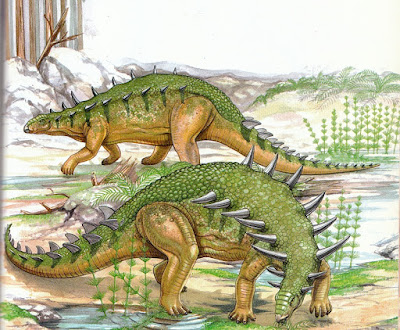Having already looked at saurischian dinosaurs in my first two posts on the 1987 Childcraft annual, it's high time some ornithischians were allowed to show their controversially cheeked faces. There's some more Greg Paul art in this category, but why don't we start with something that proved popular on Facebook?
Commendably, an early chapter attempts to explain taxonomy and nomenclature to children - an impressively difficult task, given how poorly adults seem to grasp it. Naturally, this includes a few examples of dinosaurs that were named after things they resemble, including good ol' Psittacosaurus above. Unfortunately, Jim Channell's illustration of the animal appears to be in a serious funk, like it just saw a vision of the future in which Donald Trump's boot stamps on a human face, for ever. Nice neck folds, but poor Psittacosaurus could really do with a nice cup of tea and a biscuit. Also, it's got an ear where it really shouldn't be. Easy mistake.
Further down the ceratopsian family tree, the book naturally includes Triceratops, as illustrated by Colin Newman. Excellent idea to have them mostly just standing around eating plants and enjoying the (sloping!) scenery, even if there are a few perspective fudges (so where are the horns on the foreground individual coming from?). The animal dramatically facing the viewer is more than a little reminiscent of Sibbick's Normanpedia Styracosaurus, an image so striking that illustrators throughout the late '80s and into the '90s found it impossible to forget.
If you do want ceratopsian-tyrannosaur face-offs, however, Greg Paul's got 'em. And what an image. Just as with his apatosaurs, it's an (even more aptly) confrontational piece that isn't afraid to show off the animal's strange attributes to their fullest extent. It's surprisingly rare that ceratopsians are made to look intimidating - often, they're the noble knights in scaly armour, locked in combat with tyrannosaurian dragons - but the theropod here looks positively puppy-like against that brick wall of a frill. Wonderful stuff.
Paul also contributes an illustration of Pachycephalosaurus in a conspicuously modern guise (i.e. with a proportionately large head), in which the animals turn their domed skulls against an unfortunate young tyrannosaur, rather than each other. Unusual perspectives abound here, too; there's that tyrannosaur sprinting away from the viewer, of course, but there's also a Pachycephalosaurus viewed head-on, unfortunately cropped out here (sorry). Just as with Apatosaurus, the fat behind on his Pachycephalosaurus shows Paul's commitment to making these animals as weird as they really were, as well as his eye for anatomical detail.
While work from other illustrators can't help but pale next to Paul's in terms of anatomical rigour, there's still a lot that's charming about it. This spread, by John Francis, depicts a herd of retro-dino-book favourite and Prehistoric Beast star Monoclonius seeing off a perturbed tyrannosaur, who steals a nervous glance over his shoulder while hot-footing it back into the woods. Monoclonius is one of those dubious genera, like Trachodon, that was once referred to very commonly in popular books (there was even a Dino Riders toy), with illustrations usually based on better-known animals. Perhaps someone should design a t-shirt - "Trachodon&Monoclonius&Deinodon&Didanodon." I'm sure Matt Martyniuk would buy one.
Tyrannosaurs can't always be allowed to escape with their dignity intact, of course (see also: Walking With Dinosaurs, Jurassic Park 3), so here Rexy is subjected to a rigorous clubbing from a cross-looking ankylosaur. Although ostensibly Ankylosaurus, the animal is modelled - typically for the time - on other ankylosaurs, mostly Scolosaurus. Fittingly, this scene combines '80s-style tail-lashing ankylosaurs with old-school squatting ones; the posture of the individual on the right is reminiscent of those good old sprawling scolosaurs, even if the overall look is more up-to-date. I like how Francis has drawn Rexy with both of his overgrown chicken feet flying up into the air. That must have been some wallop.
Ankylosaurs aren't always so bothersome, and here Phil Weare has depicted a pair just hangin' around in a swamp, chewin' on some horsetails and that. It's calling itself Hylaeosaurus, but nobody's fooled; Hylaeosaurus was the brown one on the left.
And finally...I haven't featured any stegosaurs yet, so here's a luvverly bunch of kentrosaurs. It's a decent enough illustration by John Dawson, and the animals are noteworthy for having wide hips, straight limbs, erect tails, and heads raised off the ground (which is more than can be said of many of the Stegosaurus restorations in this book). The way the animals are arranged across the spread, with dead space in between, helps encourage the suggestion that we're walking among them. Yes. Followers of dino-fashion may have noticed that the Kentrosaurus' 'shoulder spines' are located closer to the hips here - this was in style back in the day, before other stegosaurs with shoulder spines made people reconsider. However, one does note that plateosaur enthusiast Heinrich 'Caudofemoralis' Mallison, among others, contends that the spike should stay a-swayin' on the animal's hips, and not without reason. There's rarely a settled deal in dinosaur palaeontology, after all..








No comments:
Post a Comment